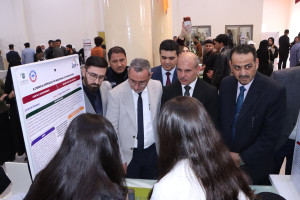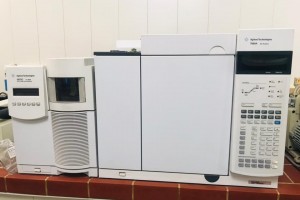
The College of Education for Pure Sciences discusses a PhD thesis on the ability of some green algae isolated from Iraqi waters in Basrah Governorate to produce biodiesel and the use of some nanoparticles in its production and improving its efficiency
The thesis presented by the researcher (Sadad Asad Mutashar) included the production of biofuel represented by biodiesel from some green algae isolated from the aquatic environment in Basrah Governorate, southern Iraq, after being diagnosed phenotypically and genetically, which were represented by Chlorella sorokiniana, Chara vulgaris, Oedogonium brevicingulatum, Spirogyra varians, Ulva flexuosa and Zygnema. carinthiacum. The algal oil was extracted from it using a mixture of chloroform - methanol. The algal oil was identified using the gas chromatography-mass spectrometry (GC-MS) technique, and the results showed that it contained saturated and unsaturated fatty acids. The active groups were also determined using the FTIR infrared spectroscopy technique. Biodiesel was produced using the direct and indirect esterification method of algal oil, and the esters of its constituent saturated and unsaturated fatty acids were identified using the mass spectrometry technique. The effective groups, which were represented by the methyl and ethyl groups, which are an important part of the hydrocarbon chain constituting the esters of the fatty acids, were determined using Infrared spectroscopy technology. In this study, AgNPs were synthesized from the extracts of three species of algae, namely C. sorokiniana, Z. carinthiacum and Z. carinthiacum.
S. varians Fe3O4NPs iron oxide nanoparticles were also produced from the extract of S. varians algae, and the nanoparticles were identified using ultraviolet-visible spectroscopy and scanning electron microscopy (SEM), which showed that they had spherical shapes and their diameters ranged between ((50.63-19.92 nm), and diffraction was used X-ray XRD, which determined the crystal form of the particles, recorded the highest percentage of oil produced from C. sorokiniana algae, which amounted to 30.5%, and rose to 35% when adding the nanoparticles produced during the study.As for the produced biodiesel, the highest percentage of oil was recorded from C. sorokiniana algae. sorokiniana, which amounted to 83%, and the characteristics of the biodiesel produced from the studied algae, which were represented by density, kinematic viscosity, degree of blurring, degree of spillage, and acidity value, which were in conformity with international specifications, were determined based on the standard methods set by the American Society for Testing and Materials ASTM.









